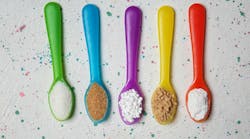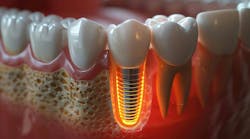How do xylitol, hydroxyapatite, and fluoride work? Do we want them in our toothpaste?
Xylitol is an FDA-approved natural sugar alcohol found in various foods. It’s commonly used as a sugar substitute because it provides sweetness without adding calories. Xylitol is beneficial for oral health because it inhibits bacterial growth, binds with calcium for tooth remineralization, and has anti-inflammatory properties.1
The most common issue associated with xylitol is bloating or diarrhea if it’s consumed in large amounts. This suggests that xylitol may contribute to increased blood clot formation and could have more significant effects on people with irritable bowel syndrome.2
Hydroxyapatite works by preventing or reducing demineralization.3 Nanohydroxyapatite is becoming popular as an alternative to fluoride toothpaste for people who want to use less fluoride. Nanohydroxyapatite acts as a remineralizing agent, reducing dentinal hypersensitivity and aiding in bone regeneration.4
Controversy surrounding fluoride
There’s some controversy around nanohydroxyapatite involving concerns that the nanoparticles may penetrate the skin and affect organs. While there’s no evidence supporting these claims, the European Union has prohibited the use of nanohydroxyapatite in cosmetics and toothpaste.5 Neither nanohydroxyapatite nor hydroxyapatite have been approved by the FDA.
Fluoride has been celebrated as one of the great achievements in public health in the 20th century.6 It’s a naturally occurring substance that reduces enamel demineralization caused by plaque acid, aids in remineralizing early cavities, and inhibits bacteria. Fluoride also helps transfer calcium and phosphate ions into the enamel, making it more acid-resistant.
Although fluoride can be toxic at high concentrations, everyday use in drinking water and dental products such as toothpaste and mouthwash is unlikely to cause toxicity.7 Some studies have assessed fluoride's potential impact on neurology and bone growth, but no evidence has conclusively linked it to these issues.7 Fluoride is FDA-approved as a class II medical device for cavity liners and tooth desensitization.
Extensive research has been conducted on many dental products, generating much speculation about their benefits and drawbacks. Fluoride has been widely accessible and used in the dental industry for many years and has proven to be effective. An effective product would contain fluoride, xylitol, and hydroxyapatite.8 There are several products that contain all three. These ingredients have beneficial properties and can be used to help prevent dental caries, but more research is needed on hydroxyapatite products in dentistry.
When deciding which type of cavity prevention you want to recommend in a toothpaste or rinse, consider your patient's needs. If a patient is cavity-prone and has gum inflammation, recommending a xylitol product is good because it can help with both issues. If a patient already has decalcification of the enamel and wants to prevent future decay, recommend a product with hydroxyapatite. If the patient is cavity-prone, fluoride has been proven to help with cavity prevention.
References
1. Loimaranta V, Mazurel D, Deng D, Söderling E. Xylitol and erythritol inhibit real-time biofilm formation of Streptococcus mutans. BMC Microbiolhello. 2020;20(1):184. doi:10.1186/s12866-020-01867-8
2. Riley P, Moore D, Ahmed F, Sharif MO, Worthington HV. Xylitol-containing products for preventing dental caries in children and adults. Cochrane Database Syst Rev. 2015;2015(3): doi:10.1002/14651858
3. O'Hagan-Wong K, Enax J, Meyer F, Ganss B. The use of hydroxyapatite toothpaste to prevent dental caries. Odontology. 2022;110(2):223-230. doi:10.1007/s10266-021-00675-4
4. Bordea IR, Candrea S, Alexescu GT, et al. Nano-hydroxyapatite use in dentistry: a systematic review, Drug Metab Rev. 2020;52:2:319-332. doi:10.1080/03602532.2020.1758713
5. Opinion on hydroxyapatite (nano). Regulatory toxicology and pharmacology. 2018;98:274-275. https://doi.org/10.1016/j.yrtph.2018.07.018
6. Murthy VH. Surgeon General's Perspectives. Public Health Rep. 201;130(4):296-298. doi:10.1177/003335491513000402
7. Arifa MK, Ephraim R, Rajamani T. Recent advances in dental hard tissue remineralization: a review of literature. Int J Clin Pediatr Dent. 2019;12(2):139-144. doi:10.5005/jp-journals-10005-1603
8. Meshki R, Basir L, Rahbar N, Kazempour M. Comparison of the effect of fluoride gel and two toothpastes with different materials on remineralization of initial carious lesions in primary teeth. J Family Med Prim Care. 2021;10(9):3309-3313. doi:10.4103/jfmpc.jfmpc_1046_21
About the Author
Chrissy Harlow, BSDH, RDH
Chrissy Harlow, BSDH, RDH, is an experienced dental hygienist committed to exceptional patient-centric care in a comfortable and supportive environment. She is an experienced problem-solver who can troubleshoot issues and develop solutions. Chrissy thrives in collaborative environments. She’s dedicated to supporting the entire dental office and creating positive experiences for patients and staff.


